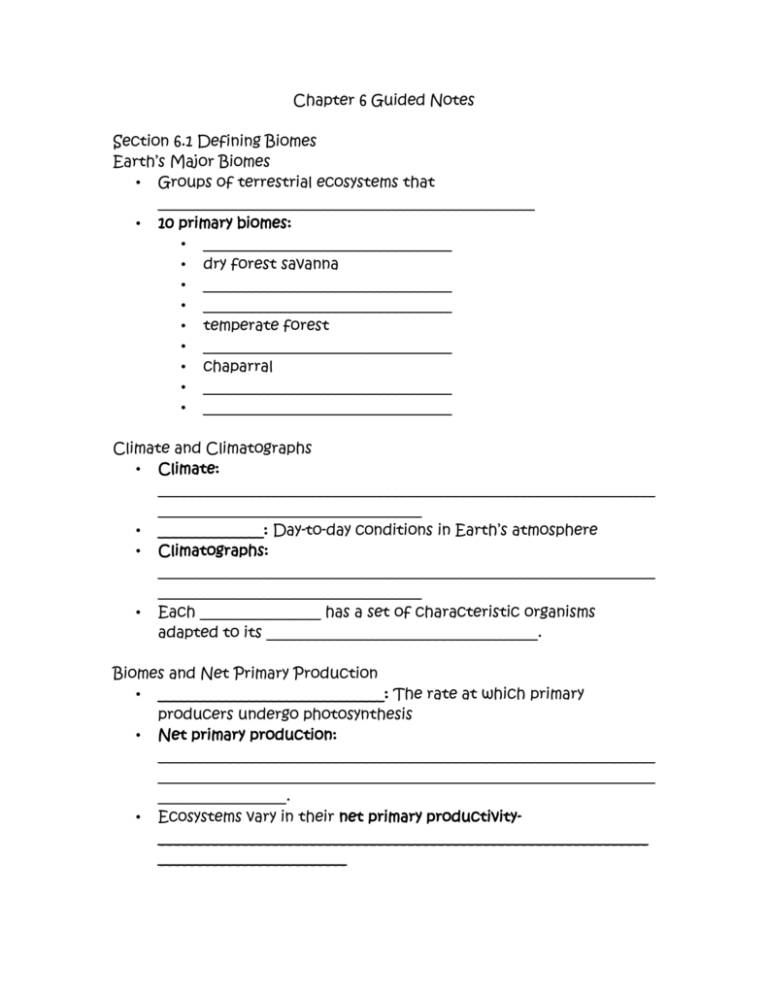Biomes & Ecosystems Guided Notes: Definitions & Types
advertisement

Chapter 6 Guided Notes Section 6.1 Defining Biomes Earth’s Major Biomes • Groups of terrestrial ecosystems that __________________________________________________ • 10 primary biomes: • _________________________________ • dry forest savanna • _________________________________ • _________________________________ • temperate forest • _________________________________ • chaparral • _________________________________ • _________________________________ Climate and Climatographs • Climate: __________________________________________________________________ ___________________________________ • ______________: Day-to-day conditions in Earth’s atmosphere • Climatographs: __________________________________________________________________ ___________________________________ • Each ________________ has a set of characteristic organisms adapted to its ____________________________________. Biomes and Net Primary Production • ______________________________: The rate at which primary producers undergo photosynthesis • Net primary production: __________________________________________________________________ __________________________________________________________________ _________________. • Ecosystems vary in their net primary productivity_________________________________________________________________ _________________________ • Warm, wet biomes generally have _____________ net primary productivity than cold, dry biomes. Section 6.2 Biomes Tropical Rain Forest • Year-round ______________________ and _________________________________________________ • Soil generally _______________________________ • ______________________________________________ support enormous variety of plants. • Plants tend to have _________________________________________________. • __________________________________________________________________ __________________________________________________________________ _____________________. Tropical Dry Forest • Warm year-round, ____________________________________. • Most trees are ________________________—they lose their leaves and cease photosynthesis part of the year. • Plants and animals __________________________________________________________________ ___________________________________ Savanna • Receives __________________________________________________________________ _____________________________ usually has a distinct rainy season • Grasses __________________________ with groups of trees • __________________________________________________________________ ________________________________ • Plants are adapted to ___________________________; tend to be deciduous with deep roots, thick bark, and waxy coatings on leaves. • Many animals __________________________________________________________________ ______________________________. Desert • Receives ____________________ (9.8 in.) of precipitation per year • Temperatures ________________________________________________ • Plants tend to have thick, leathery leaves, ___________________ in their tissues, and have shallow roots. • Animals get most of their water from the __________________________________________________________________ __________________________________________________________________ ___________________ Temperate Rain Forest • Year-round __________________________________________________________________ _________________________________ • Largest extent found in __________________________________________________________________ _________________________________ • Characterized by tall evergreen trees, such as cedars and hemlocks, that don’t lose leaves annually; many are ______________________________________________ • Forest floor is ___________________________________. • Animals __________________________________________________________________ ______________________________ Temperate Forest • Precipitation __________________________________________________________________ ________________________________ • Varied temperatures (____________________________________________) • Plants tend to be _________________________________________________. • Soil is __________________________________________________________________ ________________________________. • __________________________________________________________________ ____________________________________ Temperate Grassland (Prairie) • • • • _________________ seasonal precipitation and fairly extreme seasonal temperatures; _______________________________ ____________________________________________ to support large trees; grasses, which grow from their base, thrive despite droughts, fires, animals grazing Animals are _____________________________________________. Soil tends to be rich in nutrients; __________________________________________________________________ ____________________________________. Chaparral • Highly seasonal conditions with __________________________________________________________________ ___________________________________ • Prolonged _________________________; droughts and fires common • Plants are ___________________________; many have thick, waxy leaves or leaves with hairs that trap moisture; succulents are common. • Plants may have thick bark and deep roots to resist fire; __________________________________________________________________ __________________________________ • __________________________________________________________________ ___________________________________. Boreal Forest (Taiga) • ___________________________________________________ • ________________________________, slightly acidic soils • __________________________________________________ • Coniferous trees with waxy needles and conical shape, __________________________________________________________________ __________________________________. • Animals feed, breed, and care for young mostly during short warm season; year-round residents tend to have __________________________________________________________________ ____________________________________ Tundra • Extremely _________________________; relatively sunny and cool summers • • • • Found at very _________________________________________ Harsh winds, nutrient-poor soil, and freezing temperatures ______________________; no tall trees; mosses and lichens common Characterized by _____________________(underground soil that is frozen year-round) Birds and caribou migrate to the tundra during the mild summer to feed on insects and lichens; only a __________________________ Polar Ice and Mountains • _____________________________________________ • _______________________________________ in Northern Hemisphere; ice sits atop Antarctica in Southern Hemisphere • Very few plants; _________________________________________________ • Mountain communities change with _____________________, similar to how biome communities change with __________________________ Section 6.3 Aquatic Ecosystem Describing Aquatic Ecosytems • ______________________: the amount of dissolved salt present in water. Ecosystems are classified as salt water, fresh water, or brackish depending on salinity. • Photosynthesis tends to be limited by light availability, __________________________________________________________________ _______________________ • Aquatic ecosystems are either _________________________________________________. • Aquatic ecosystem zones: _________________________________________________ Freshwater Ecoystems: Ponds, Lakes, Inland Seas • Salinity is less than ___________________ (parts per thousand) • Ponds and lakes are similar, except in size, but __________________________________________________________________ __ • Ponds and lakes are divided horizontally into zones: ______________________________________________ Freshwater Ecosystems: Wetlands • • • Areas of land _______________________________ at least part of the year Include ___________________________________________________ Wetlands prevent __________________________________________________________________ __________________________________ Freshwater Ecosystems: Rivers and Streams • Bodies of surface water that _____________________, eventually reaching an ocean or inland sea • ________________________: The area of land drained by a river and its tributaries • Characteristics, such as __________________________________________________________________ ___________________________________ Estuaries • Occur where a river flows into the ocean or an inland sea • Coastal estuaries are brackish ecosystems; organisms must tolerate wide salinity and temperature ranges. • Coastal estuaries are home to salt marshes and mangrove forests. • Like wetlands, estuaries help prevent flooding and soil erosion as well as provide habitats. Oceans • Currents are driven by __________________________________________________________________ ________________________________ • Surface winds and heating generate vertical currents that __________________________________________________ • Horizontal ocean zones: _________________________________________________ • __________________________: photic, aphotic, benthic Ocean Ecosystems • Intertidal: __________________________________________________________________ ____________________________________ • • ____________________: Productive kelp forests and coral reefs provide habitats and help protect shorelines from erosion. Open ocean: __________________________________________________________________ __________________________________________________________________ __________________________________________________________________ ____









